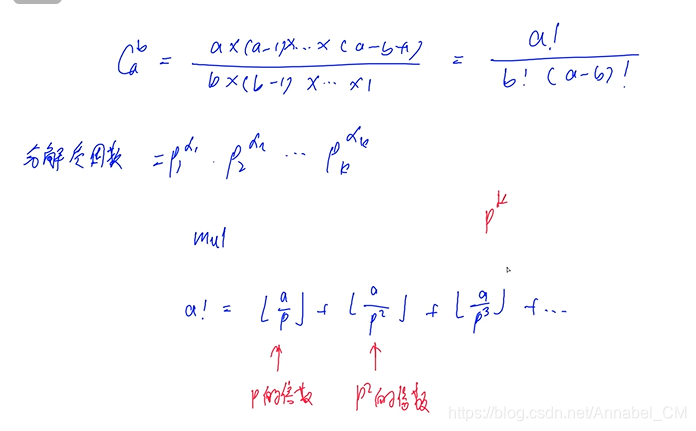文章目录
组合数的公式:

一、递推(杨辉三角)
AcWing 885. 求组合数 I
给定n组询问,每组询问给定两个整数a,b,请你输出Cba mod (109+7)的值。
输入格式
第一行包含整数n。
接下来n行,每行包含一组a和b。
输出格式
共n行,每行输出一个询问的解。
数据范围
1≤n≤10000,
1≤b≤a≤2000
输入样例:
3
3 1
5 3
2 2
输出样例:
3
10
1


#include <iostream>
#include <algorithm>
using namespace std;
const int N = 2010, mod = 1e9 + 7;
int c[N][N];//将所有的组合方式都预处理出来
void init()
{
for (int i = 0; i < N; i ++ )
for (int j = 0; j <= i; j ++ )
if (!j) c[i][j] = 1;//如果最后j为0,Ca/0为最终情况
else c[i][j] = (c[i - 1][j] + c[i - 1][j - 1]) % mod;
}
int main()
{
int n;
init();
scanf("%d", &n);
while (n -- )
{
int a, b;
scanf("%d%d", &a, &b);
printf("%d\n", c[a][b]);
}
return 0;
}
二、乘法逆元
AcWing 886. 求组合数 II
给定n组询问,每组询问给定两个整数a,b,请你输出Cba mod (109+7)的值。
输入格式
第一行包含整数n。
接下来n行,每行包含一组a和b。
输出格式
共n行,每行输出一个询问的解。
数据范围
1≤n≤10000,
1≤b≤a≤105
输入样例:
3
3 1
5 3
2 2
输出样例:
3
10
1

#include <iostream>
#include <algorithm>
using namespace std;
typedef long long LL;
const int N = 100010, mod = 1e9 + 7;
int fact[N], infact[N];//fact表示阶乘,infact表示阶乘的逆元
int qmi(int a, int k, int p)//求逆元
{
int res = 1;
while (k)
{
if (k & 1) res = (LL)res * a % p;
a = (LL)a * a % p;
k >>= 1;
}
return res;
}
int main()
{
fact[0] = infact[0] = 1;
for (int i = 1; i < N; i ++ )
{
fact[i] = (LL)fact[i - 1] * i % mod;//阶乘运算过程
infact[i] = (LL)infact[i - 1] * qmi(i, mod - 2, mod) % mod;
}
int n;
scanf("%d", &n);
while (n -- )
{
int a, b;
scanf("%d%d", &a, &b);
printf("%d\n", (LL)fact[a] * infact[b] % mod * infact[a - b] % mod);//mod两次是为了防止结果过大,导致溢出
}
return 0;
}
三、卢卡斯定理
AcWing 887. 求组合数 III
给定n组询问,每组询问给定三个整数a,b,p,其中p是质数,请你输出Cba mod p的值。
输入格式
第一行包含整数n。
接下来n行,每行包含一组a,b,p。
输出格式
共n行,每行输出一个询问的解。
数据范围
1≤n≤20,
1≤b≤a≤1018,
1≤p≤105,
输入样例:
3
5 3 7
3 1 5
6 4 13
输出样例:
3
3
2


#include <iostream>
#include <algorithm>
using namespace std;
typedef long long LL;
int qmi(int a, int k, int p)//快速幂求a^k (mod p)
{
int res = 1;
while (k)
{
if (k & 1) res = (LL)res * a % p;
a = (LL)a * a % p;
k >>= 1;
}
return res;
}
int C(int a, int b, int p)//计算c(a, b)
{
if (b > a) return 0;
int res = 1;
for (int i = 1, j = a; i <= b; i ++, j -- )
{
res = (LL)res * j % p;
res = (LL)res * qmi(i, p - 2, p) % p;
}
return res;
}
int lucas(LL a, LL b, int p)//公式:c(a, b) = c(a % p, b % p)·(a / p, b / p)
{
if (a < p && b < p) return C(a, b, p);
return (LL)C(a % p, b % p, p) * lucas(a / p, b / p, p) % p;
}
int main()
{
int n;
cin >> n;
while (n -- )
{
LL a, b;
int p;
cin >> a >> b >> p;
cout << lucas(a, b, p) << endl;
}
return 0;
}
四、 质因数分解
乘法逆元只能处理模数为大质数的情况,卢卡斯定理只能处理模数为质数的情况,那有没有一种方法能处理模数不是质数的情况呢?显然是有的。而且不取模也是可以的。
我们可以把组合数中要乘或除的每一个数分解质因数,再把分母的质因数减掉,最后把剩下的质因数乘起来,边乘边模p就行了。
那如何分解质因数呢?可以用欧拉筛把每个数的最小质因数求出来,把i的最小质因数的编号保存在min_prime[i]里。
具体看代码吧。
AcWing 888. 求组合数 IV
输入a,b,求Cba的值。
注意结果可能很大,需要使用高精度计算。
输入格式
共一行,包含两个整数a和b。
输出格式
共一行,输出Cba的值。
数据范围
1≤b≤a≤5000
输入样例:
5 3
输出样例:
10


#include <iostream>
#include <algorithm>
#include <vector>
using namespace std;
const int N = 5010;
int primes[N], cnt;
int sum[N];
bool st[N];
void get_primes(int n)//线性筛素数
{
for (int i = 2; i <= n; i ++ )
{
if (!st[i]) primes[cnt ++ ] = i;
for (int j = 0; primes[j] <= n / i; j ++ )
{
st[primes[j] * i] = true;
if (i % primes[j] == 0) break;
}
}
}
int get(int n, int p)//得到n!中p的次数;
{
int res = 0;
while (n)
{
res += n / p;
n /= p;
}
return res;
}
vector<int> mul(vector<int> a, int b)
//高精度乘法;
{
vector<int> c;
int t = 0;
for (int i = 0; i < a.size(); i ++ )
{
t += a[i] * b;
c.push_back(t % 10);
t /= 10;
}
while (t)
{
c.push_back(t % 10);
t /= 10;
}
return c;
}
int main()
{
int a, b;
cin >> a >> b;
get_primes(a);
for (int i = 0; i < cnt; i ++ )
{
int p = primes[i];
sum[i] = get(a, p) - get(a - b, p) - get(b, p);//得到C[a][b]中p的次数,因为是幂的形式,所以是减;
}
vector<int> res;
res.push_back(1);//要先放进去一个1;
for (int i = 0; i < cnt; i ++ )
for (int j = 0; j < sum[i]; j ++ )
res = mul(res, primes[i]);
for (int i = res.size() - 1; i >= 0; i -- ) printf("%d", res[i]);
puts("");
return 0;
}
作者:yxc
链接:https://www.acwing.com/activity/content/code/content/53401/
来源:AcWing
总结
写了这么多种算法,每种算法都有其优点与局限性。递推写起来快,思维简单,但时间复杂度高。乘法逆元用得比较普遍,因为一般都是模一个大质数,复杂度也几乎是线性的。卢卡斯定理只会在特定的题目里做到,但其实编程复杂度并不高,就是在乘法逆元的基础上加几句话。质因数分解的适用性最广,编程复杂度也最高,这就是完美的代价吧。